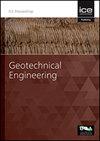双开口支撑h型钢支撑的原位轴向加载试验
IF 1.7
4区 工程技术
Q3 ENGINEERING, GEOLOGICAL
Proceedings of the Institution of Civil Engineers-Geotechnical Engineering
Pub Date : 2022-04-20
DOI:10.1680/jgeen.21.00102
引用次数: 0
摘要
介绍了某大型基坑采用h型钢支撑墙体系的设计。通过原位轴向加载试验,研究了双开口支撑HS支撑的载荷传递及变形机理。监测结果表明,外支架承受的侧向土压力最大(48.5%),其次是内支架(35.6%)和端部支架BC段(15.9%)。外、内张支、端支AB、BC段的强度稳定安全冗余度均大于1.59。随着加载过程的增加,中间支撑和整个支撑的轴向变形呈线性增加的趋势。利用监测的液压千斤顶总载荷,估计整个支柱的KT″值为158 ~ 189 MN/m。整个支杆的KT″(KT″ba/S)修正值为2.2 ~ 2.6 MN/m。它接近中国标准中建议范围的下限(2.5 ~ 3.5 MN/m)。开挖过程中典型安全控制参数的监测数据和现场加载试验的监测结果表明,该工程中带HS支板的BWS具有良好的性能。本文章由计算机程序翻译,如有差异,请以英文原文为准。
In-situ axial loading tests on H-shaped steel strut with double splay supports
The design of a large excavation using a braced wall system (BWS) with H-shaped steel (HS) struts is introduced. In-situ axial loading tests were conducted to study the load transfer and deformation mechanisms of a HS strut with double splay supports. The monitoring results indicate that the outer splay support withstands the most lateral earth pressure (48.5%), followed by the inner splay support (35.6%) and BC segment of end support (15.9%). The safety redundancies of strength and stability for the outer and inner splay supports, AB and BC segments of end support are all larger than 1.59. The axial deformations of the middle support and the whole strut tend to increase linearly with the loading process. Using the monitored total load of hydraulic jacks, the value of KT″ of the whole strut is estimated to be 158∼189 MN/m. The modified value of KT″ (KT″ba/S) of the whole strut is 2.2∼2.6 MN/m. It is close to the lower limit of the suggested range (2.5∼3.5 MN/m) in the Chinese standard. The monitored data of typical safety control parameters during soil excavation and the monitored results during in-situ loading tests indicate good performance of the BWS with HS struts in this project.
求助全文
通过发布文献求助,成功后即可免费获取论文全文。
去求助
来源期刊
CiteScore
4.40
自引率
4.50%
发文量
68
审稿时长
3 months
期刊介绍:
Geotechnical Engineering provides a forum for the publication of high quality, topical and relevant technical papers covering all aspects of geotechnical research, design, construction and performance. The journal aims to be of interest to those civil, structural or geotechnical engineering practitioners wishing to develop a greater understanding of the influence of geotechnics on the built environment.

 求助内容:
求助内容: 应助结果提醒方式:
应助结果提醒方式:


